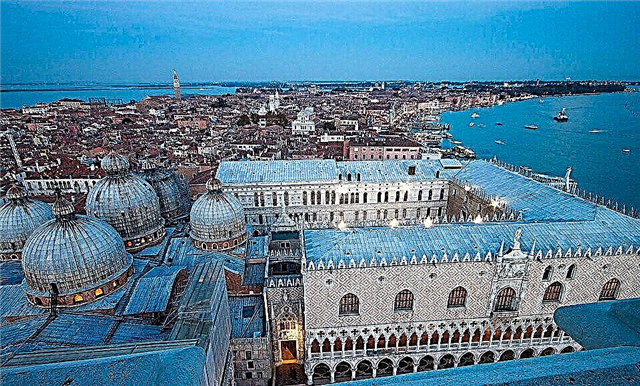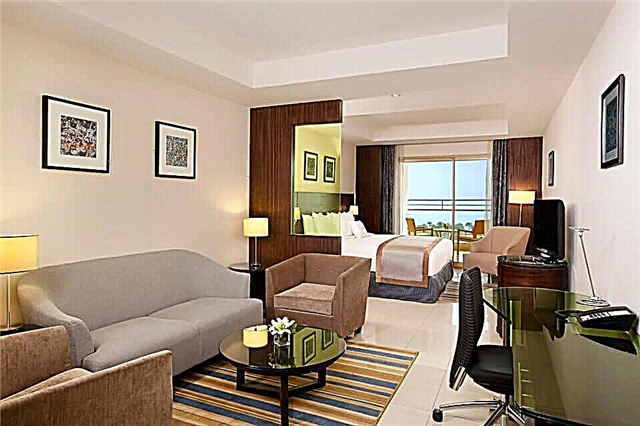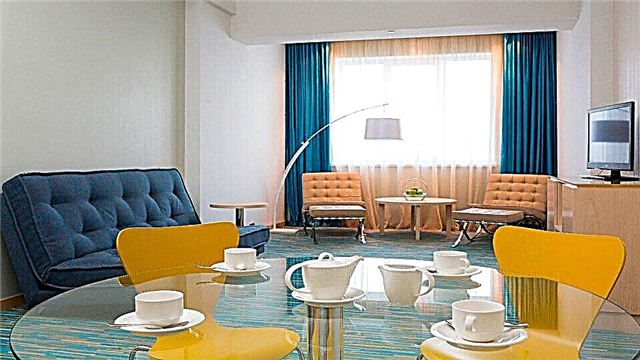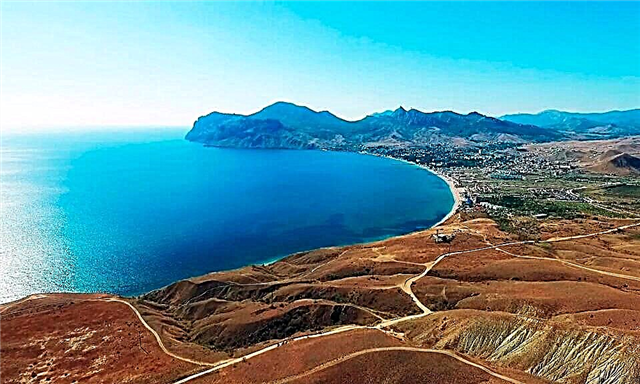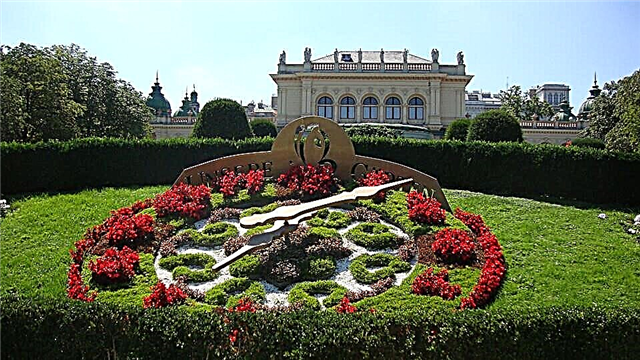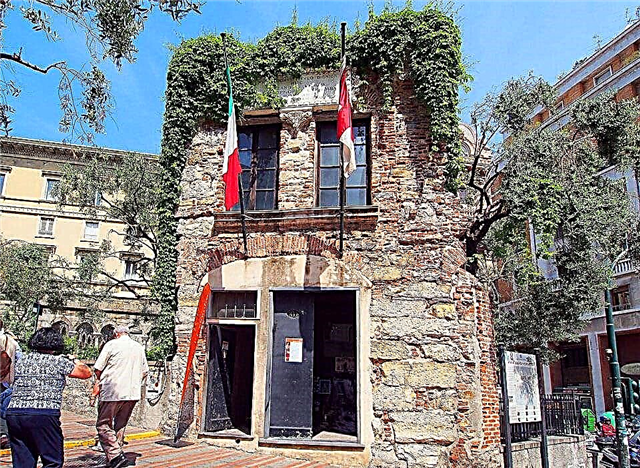The oldest city on the shores of the Gulf of Genoa, the 2nd largest seaport in Italy - truly legendary. The multifaceted history of Genoa, which began long before our era. e, left many unique monuments here. The birthplace of Christopher Columbus, Marco Polo, Genoese merchants is interesting for its history. From the first steps along the pavements of the unique city, you are imbued with a special flavor.
He lives in numerous luxurious palaces, temples and museums, in narrow cobbled streets, ancient squares - after all, Genoa is just a treasure trove of attractions. No wonder the city was awarded the status of the cultural capital of Europe. If you do not have the opportunity to stay here for a long time, at your service is an article-guide of what to see in Genoa in 1 day on your own.
It is best to walk around the city on foot or rent a segway to see the unique buildings and monuments "eye to eye". Genoa is a 2-level city with a system of 10 lifts and 2 funiculars, which greatly facilitates an independent excursion.
Genoa aquarium

Have you arrived in Genoa by train or bus at the Piassa Principe train station? Then it is very convenient for you to walk from it in 10 minutes to the Old Port - a walking tourist area. First of all, all tourists go there to see the main attractions. Among the seaside objects, the most popular is the Aquarium - the largest okenarium in Europe in terms of area (3100 sq. M).
The grandiose structure was erected on Cape Ponte Spinola for the 500th anniversary of the discovery of America by Columbus in 1992. You will be impressed by the extraordinary appearance of the building, which looks like a ship launched into the water. To save 20 €, it is worth purchasing a comprehensive ticket at the box office, which includes a visit to the Aquarium and museums. (It will not be superfluous to immediately buy a map of the historic center of Genoa) Advice: in order not to waste time standing in line, it is better to “check out” in advance on the Internet through the institution's website.
Each of the 70 aquariums featured in this stunning world of water and glass is a distinct ecosystem inhabited by inhabitants of different climatic zones. Walking between the transparent walls, you will get to know a fantastic world inhabited by sharks, caimans, piranhas, dolphins, seals and other representatives of marine fauna and flora. If you are lucky, you will see an amazing show with dolphins, you can feed stingrays and even pet them. Believe me, the impressions of visiting the "Aquarium" will not fade from memory for a long time.
Botanical Garden "Biosphere"

Leaving the "Aquarium", walk through Ponte Spinola and at 190 meters you will see a huge glass ball, which is impossible to miss. Shimmering with reflections of the blue sky, white clouds and the blue of the sea, it looks like a giant Christmas tree decoration. This is a unique museum-garden "Biosphere", also associated with the name of Columbus.
The glass sphere is a symbol of the globe around which the great discoverer floated. This miracle of modern architecture was erected right on the water, but there is no swing due to the solid strengthening of the foundation. Once inside, you find yourself among a tropical garden with representatives of the flora of South America, where Columbus's expedition docked.
The most sophisticated computer system regulates the climate control of the room around the clock. Palm trees, lianas, ferns and other exotic vegetation will make you forget that all this is not in their natural environment. Walking in a circle along the walls, you will see parrots, turtles, butterflies of fantastic colors. White triangles of sails soar above the multicolored green riot of flora - another symbol of sea travel. Coming out of here, undoubtedly, you will think about the diversity of living nature and about the careful attitude towards it.
Galata Maritime Museum

At 200 meters from the "Aquarium" there is an equally interesting object, available to you with a combined ticket, if you have one. "Galata" - the place from where they began their voyage and where the fateful Genoese ships were kept. The museum's 5-storey glass building, opened in 2004, houses all kinds of maritime exhibits.
The entire history of the development of shipbuilding and navigation clearly passes before our eyes. Fragments of ships of different eras, rigging items, maps of sea voyages, portholes, tools, latrine figures of ancient ships on the 1st and 2nd floors illustrate the evolution of maritime affairs.
The 3rd floor introduces the emigration of Italians to America. You, as an emigrant, will be handed a passport at the entrance, and you will go on a quest trip on a "big liner" across the ocean. This action will appeal not only to children, but also to adults. The next floors also have a lot of "highlights". You can practice on a yacht or other vessel simulator to choose from. The peak of the inspection is the real submarine S518 Nazano Sauro, which you inspect from the inside.
Lighthouse La Lanterna

Another symbol of Genoa is located 20 meters from the Galata Museum - the almost 900-year-old La Lanterna lighthouse. Built in 1128, it has become a guiding star for many generations of sailors. For some time, a lighthouse maintenance tax was levied on ships entering the port. For one year (1400th) a prison was housed in its premises. In the 16th century. it had to be reconstructed after the destruction of Genoa and France by the war.
The ancient building is also interesting because its history is connected with the name of Columbus: the navigator's uncle served as a lighthouse keeper in 1449. Technical progress, which does not stand still, has repeatedly touched the lighthouse. From time to time, the lighting system of La Laterna was modernized.
Outdated lanterns were replaced in 1874 with rotating Fresnel lenses (they are now kept in the museum). The electrics were repeatedly altered and Lanterna was rebuilt after the bombing of the British-American Air Force in 1945. La Lanterna for the Genoese is a symbol of steadfastness and resilience.
Panoramic elevator "Il Bigo"

You will experience the feeling of flight on the panoramic lift "Il Bigo". The outlandish structure, erected on the occasion of the 500th anniversary of the discovery of America, is located right there, in the Old Port, on the shore of the bay. A large round cabin, suspended from a powerful boom of a giant semblance of a harbor crane, is the elevator itself. It can accommodate 30 people at a time, lifting them to a height of almost 40 meters.
Interestingly, the simulated crane has several booms, in addition to the one on which the cab is attached. The rest of the arrows on the cables hold the roof of the concert hall located in the bay. You’ll be lucky if there’s no queue and you don’t have to wait long. But usually in the morning there are fewer people, and with a combined ticket in hand, you won't have to wait long to get up.
From above, a 360-degree view of the stunning views of the old city and the port opens. Of course, judging by the reviews, the impression is spoiled by the overcrowding of people in the cockpit. But the beautiful panorama of the city, the feeling of flight compensate for this inconvenience. Are you hungry?
Many small restaurants on the territory of the old port are at your service. The fish restaurant located in the Eataly grocery supermarket on the 1st floor has earned commendable reviews. The freshest seafood and Ligurian fish will satisfy and delight you. In addition, there are pizzerias and cafes around where you can have a quick snack.
Palazzo San Giorgio

Once you have strengthened your strength, you can move on to explore the iconic sights of Genoa. 5 minutes walk from Il Bigot is Caricamento Square, which you can easily find. The elegant old building of the Palace of San Giorgio, decorated with frescoes and sculptures, deserves undoubted attention here.
Built in the 13th century, it is not distinguished by overly intricate architecture. But it is precisely this simplicity of lines, combined with exquisite decor, that makes San Giorgio a beautiful and sophisticated building.The graceful coloring of the facade gives it a fabulous look.
The history of the palace is truly amazing and is associated with the names of the great Genoese. Even the building material has historical significance: it was brought from Constantinople, taken from the destroyed embassy of Venice. Initially, the building served as an administrative and political center, then it was used as a prison (14th century).
The famous prisoner in it was Marco Polo, under whose dictation his travel memories were recorded. At 15 in the palace there was a bank of the same name, the client of which was Columbus himself. Today, the port administration is located in the most beautiful palace of the city.
Cathedral of San Lorenzo

Moving further along the coast, you will confidently come to the quarters of the Old City. Here, focusing on the map, you need to get off at via di Scurreria and walk to pl. San Lorenzo, where the eponymous cathedral is located. The main Cathedral of Genoa makes a mesmerizing impression. From a distance, its upper part appears to be striped due to the alternation of different colors in the marble finishing. According to rumors, the cathedral contains the relics of John the Baptist, a lock of the Mother of God and a copy of the notorious Grail.
In the external appearance of the temple, which was built in 3 centuries, Gothic, Renaissance and Romanesque styles were mixed. But this did not spoil its appearance, but gave it a special originality, beauty and mysterious attractiveness. The massive staircase around the entire perimeter of the facade, expressive sculptures of lions, and majestic columns will be very impressive. If you want to go inside, admission is free. But the interiors of San Lorenzo are not as fascinating as the exteriors. Especially if you have already visited, for example, Roman temples.
Porta Soprano Gate

Having admired the main cathedral, it is worth going forward 300 meters to find yourself in front of the towers of the ancient gates of Genoa. These are the noble remains of the 2nd fortress wall, erected in the 12th century. as a defense against the German conquerors. The towers, which serve as a link between the past and the present of the city, are very interesting for their architecture. On the inside, their walls are flat, and on the outside, they are rounded. Passing through the arch between them, there is a feeling of a kind of travel in time.
The fortress wall was demolished during the period of dense development of Genoa, even a house was erected on the arch. The famous Parisian executioner lived in it for several years, chopping off the heads of Louis the 16th, Marie Antoinette and the leaders of the French Revolution. For a time, the towers were used as a prison. The name of the gate comes from the word sopra, which means "above", as they are located at the top of the hill. The rest of the gate was restored in the 19th century, when the "new Middle Ages" became fashionable.
House of Christopher Columbus

Almost in the shadow of the towers of Porta Soprana, you will see a modest house with dilapidated walls, beautifully entwined with ivy. Its authentic appearance is immediately evident, but it is not the original building that Christopher Columbus lived in until 1470.
The former was destroyed by French shelling. Although it has not been reliably proven that this is exactly the house of Columbus, they tried to restore the building. The Genoese, idolizing the great countryman, and at the same time the tourists are happy to consider the modest building the shelter of the discoverer of America.
You can get inside only by prior arrangement. Or if your visit to Genoa is on October 12th, World Columbus Day. As in other house-museums, it displays the personal belongings of the navigator, marine instruments that he used. The territory adjacent to the house is picturesquely decorated, decorated with a pretty colonnade and shady trees. There is a small trattoria nearby, where you can order a full lunch with first courses and appetizers at an inexpensive price.
Ferrari square

Moving on, exit to pl. Ferrari is the financial and political "heart" of Genoa. It is located on the border between the historic part of the city and the new business center. The grandiose fountain in the middle and the surrounding of beautiful palace buildings will help you understand that you are in the main square. Until 1887 it was called San Dominica after the church of the same name. During the reconstruction, the church was demolished (1828), and the square was renamed in honor of the philanthropist, the Duke of Ferrari.
On the site of the church, the building of the Carlo Felice opera house appeared. You can easily find it by the beautiful colonnade on the facade and the equestrian monument to Garibaldi. The majestic building was rebuilt for many years after the bombing of 1945 and did not open until 1991.
Right in front of the fountain is the Doge's Palace, a rather pompous building in yellow and pink tones. You will certainly be interested in the Palazzo Doria de Ferrari Galliera - a complex of 3 buildings from the late 16th century. Now it belongs to the Banco di Roma association. Not to be missed is the Palace of Liguria, a classic building with a clock tower on the roof.
Today, the former palace of the General of Italian Shipping houses the administration of Liguria. Next to it, notice the side façade of the Ducal Palace, one of the symbols of Genoa. The central facade of the palace, erected in the 13th century, faces the square. Giacomo Matteoti. After a major restoration, a museum and a palace of culture were opened in it. Here, in the lower halls, there are fast-food establishments where you can enjoy delicious burgers and drink coffee.
Palazzi dei Rolli

Usually, after examining pl. Ferrari tourists head to st. Garibaldi (now Novaya St.), in the quarter where 40 royal palaces are located (Palazzi dei Rolli) Here, next to the Palazzo Rocco, there is a tourist office, where you can buy an entrance ticket to 3 museums. Each of the magnificent buildings is a symbol of aristocratic vanity and ambition of the owners, who sought to outdo their neighbors in luxury.
Luxurious buildings were erected in the 16-17 "century of the Genoese", when money flowed like a river. Thanks to the competition of the nobility, today we have the opportunity to enjoy the beauty of architectural masterpieces. It is impossible to get around all the palaces, so we will focus on 3 of them where museums are open. The first of them, the White Palace, built in 1540, was given over to an art gallery.
Walking through its halls, you will see the canvases of famous painters. After walking through the courtyard with a garden and a fountain, we go to the Red Palace, located opposite. Its luxurious halls house objects of art: paintings, vases, tapestries, and other objects that amaze the imagination. Leaving Palazzo Rosso, opposite you will see the next museum-palace - Palazzo Tursi. Among its exhibits are Paganini's violin and Columbus's letters - rarities sacred to Italians.
Funicular Santa Anna

We move further along the street, superficially observing the magnificent buildings, and after 250 m we find ourselves at the Santa Anna funicular. This is the very first ski lift in the city, included in the transport system of Genoa. The ticket (0.7 €) is sold in a machine installed at the bus stop. For tourists, this is an attraction, and for local residents, it is a necessary mode of transport. So don't be surprised when you find yourself in the company of the Genoese.
In fact, it is an elevator car going up the rails. It moves quite noisily, with a rattling noise like a tram. But the feeling of belonging to the history of Genoa, to its old-timers, makes the trip pleasant. And here we are in the upper city, with its lovely gardens, lovely patriarchal courtyards, with steep stairs overgrown with grass. Having examined the picturesque panorama of the "lower tier" from a height, we return to the funicular and walk along the street. Via Roma.
Di Negro Park

Via Roma leads to Sq. Corvetto, and to the left of it there is a green oasis - the Di Negro Park. In front of the entrance there is a white marble monument dedicated to the famous Italian politician D. Mazzini. Climbing up the serpentine stairs, you will see a pretty cascading waterfall, small grottoes, aviaries with birds. The handrails of the stairs, originally made of twigs and branches of trees with the help of cement and plastic, will not go unnoticed by you.
Sculptures and busts of famous Genoese are placed throughout the park. A beautiful landscape and architectural corner was created at the expense of the Marquis D.C. Di Negro, whose name became the name of the park. The villa is located on a hill, to which there are numerous paths. Nearby is the Botanical Garden with wooden gazebos and a waterfall. For some time, the villa was given to the Museum of Natural History, and now it houses the Museum of Oriental Art of David Chiossone.
Corso Italy

Leaving the park on pl. Corvetto, take bus N 3 or 18, they run every 15 minutes - in half an hour you will find yourself on Corso Italia. This most beautiful pedestrianized seaside street is definitely worth a visit. On a wide promenade, very beautifully decorated, crowds of people walk, ride rollerblades and bicycles. In fact, this is a mini-resort inside Genoa. On one side of the promenade, there are beaches, sports grounds, tennis courts, and on the other, there are chic mansions, villas and various institutions.
The embankment that emerged at the end of the 40s of the last century was thoroughly rebuilt in the early 90s of the 21st century. and turned into an elite place. There are wide comfortable benches and gazebos for relaxation.
Along the entire length of 2.5 km, the walking lane is lined with tiles with great taste in the form of geometric shapes. It will not be easy to walk the entire embankment, but the section that you can see will leave a deep impression. By the way, in this piece of paradise there are many all kinds of restaurants, cafes and eateries, including Panino Marino, where you can refresh yourself with something delicious from seafood.
Staglieno Monumental Cemetery

Not every tourist visiting Genoa visits the Staglieno cemetery. However, it is even difficult to call it that word. Rather, it is a museum of marble sculptures. From "Corso Italia" you can get to the cemetery by bus N 70, 75, 76, 15, 25, travel time 40-42 minutes. Take your time - the "Museum of Monuments" will make a strong impression. It is not for nothing that Hemingway called Staglieno one of the wonders of the world. After passing along the high wall forward, turn right around the corner and you will see the entrance.
It leads to a covered gallery, on both sides of which there are sculptural masterpieces. The huge square is occupied by hundreds of marble statues, each of which is a work of art. 200 years ago, the authorities of Genoa bought out a plot of land on the outskirts of the city, but only in 1844 the construction of the cemetery began.
The project was supervised by the famous Genoese architect Barabino, who did not manage to live to see the opening of the cemetery. The monumental sculptures of the noble Genoese buried here reflect the funeral themes.
All compositional figures amaze with the grace of the image and the exquisite skill of the sculptors. The marble faces of the characters express a deep feeling of grief over the loss of a loved one. Staglieno was visited at different times by famous classics of literature, painting, prominent politicians. Returning on the bus back, you will comprehend what you saw all the way.



